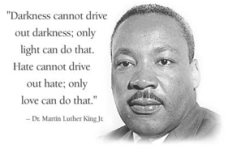Find Us
About This Site
Creative Transitions, Inc. is a 501(c)(3) nonprofit organization that was founded in 2018 by Jean Meier M.Ed.
Helping mid-career individuals bring innovation, creativity, and meaning into their work to make a difference in the world.
I grew up seeing Martin Luther King and the fire hoses and dogs on TV. The civil rights movement was a formative influence for me even if I was a little too young to actively participate. Nonviolence principles as embodied by Martin Luther King and Gandhi, among others, remain a guiding light for me. Is it still relevant today?

I was in high school when Martin Luther King gave his “I Have a Dream” speech as part of the March on Washington. I would have loved to take off for Alabama that summer, marching and helping with voter registration, but that didn’t go over so well with my parents.
At the time, nonviolence was, for me, about “us” the good people against “them” those Southerners who dared to turn the dogs and the fire hoses on undeserving innocents. I wanted to stomp out the evil I saw every night on TV. Marches, demonstrations, and sit-ins seemed like a good way to do that.
Nonviolence, on the surface, seems to be a way to fight against or resist, just to do it without physical violence. After all MLK used nonviolence to fight against racism and bigotry. Ghandi used it to fight against the British colonization of India. Mandela used it to fight against apartheid.
Yet, there is a lot more to nonviolence than simply acting without physical violence. Nonviolence may be about fighting injustice yet, at its core, it’s not about fighting against. It’s about love.
How exactly does this relate, in the real world, to the many challenges we’re facing today?
Eswaren writes:
“Gandhi gave us the basis for a technology of peace. He gave us tools for resolving conflicts of all kinds, which anyone can learn to use. But it is urgent to understand his message that nonviolence is a way of thinking, a way of life, not a tactic, but a way of putting love to work in resolving problems, healing relationships, and generally raising the quality of our lives.”
Martin Luther King said: “Nonviolence means avoiding not only external physical violence but also internal violence of spirit. You not only refuse to shoot a man, but you refuse to hate him.”
I am far from believing that nonviolence is passive. However, I feel drawn to strengthening an understanding of the underlying principles of nonviolence while also, perhaps, adapting and expanding methods to fit changing conditions.
Stay tuned for my next blog post which addresses the question:
what does Ghandi’s form of nonviolence mean in the workplace when all of us, CEOs, managers and employees alike, face daunting challenges and often impossible demands that seem endemic to the very systems and structures within which we work?